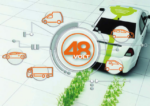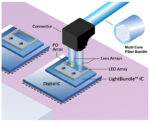If something can’t go on, it won’t; supplying the automobile’s voracious electrical demands from a 12-V battery is an example of this reality. Under the zonal architecture, many legacy loads will still be supported by a 12-V battery or its functional equivalent derived from a 48-V battery. In the mild-hybrid system, a 48-V battery is […]
FAQ
Zonal automotive power distribution can dramatically improve efficiency, weight, and cost: part 2
If something can’t go on, it won’t; supplying the automobile’s voracious electrical demands from a 12-V battery is an example of this reality. Topology changes affect the battery source Due to the 12-V issues, many newer ICE vehicles and nearly all EV/HEVs also have a 48-V battery. This battery serves loads that are more efficiently […]
Zonal automotive power distribution can dramatically improve efficiency, weight, and cost: part 1
If something can’t go on, it won’t; supplying the automobile’s voracious electrical demands from a 12-V battery is an example of this reality. Today’s cars — whether based on the traditional internal combustion engine (ICE), some form of hybrid electric vehicle (HEV), or even a pure electric vehicle (EV) — are loaded with electronics, sensors, […]
Why use a switching regulator instead of a linear regulator for DC-to-DC conversion?
Most electronic systems rely on regulators to deliver stable direct current (DC) levels. This article explains how regulators operate and reviews the two primary types of regulators used for DC-to-DC conversion: switching and linear. It also compares their advantages and limitations, highlighting common use cases and applications for each. Regulating and refining DC voltage levels […]
How does OPC UA PubSub data support connector digital twins?
The use of digital twins can be an important factor in maximizing the performance and flexibility of Industry 4.0 factories. Open Platform Communications (OPC) is the interoperability standard for the secure and reliable exchange of data in industrial automation environments. OPC has been expanded to include the unified architecture (UA), standardized as IEC 62541, that […]
Flexible PTP profiles ease the transition to 5G
5G brought architecture changes that require synchronization. Depending on the location and network site, those timing requirements require different PTP profiles and PTP capacity.
How do connectors made with conductive plastics contribute to sustainability?
Basic plastics are electrically insulating, but with the proper additives, they can become conductive. Electrically conductive plastics can be used to replace metal components and improve sustainability in several areas of connector construction. They take less energy to fabricate and are lighter, reducing system weight, a very important consideration in applications like electric vehicles (EVs). […]
How does UCIe on chiplets enable optical interconnects in data centers?
Chiplets enable heterogeneous integration of various process nodes and materials to maximize performance. UCIe is a new die-to-die interconnect standard for high-bandwidth, low-latency, power-efficient, and cost-effective connectivity between chiplets. UCIe is also the first specification to include an interface that is compatible with optical links. Large computing systems needed to support high-performance computing (HPC) applications […]
FAQ on axial flux motors: Part 3
Radial flux AC motors offer some performance and packaging benefits but also bring some thermal and manufacturability issues. Part 1 of this series examined the axial-flux motor (AFM) in detail and compared it to the very widely used radial-flux motor (RFM). Part 2 of this FAQ continued the exploration of AFMs and RFMs. This final part […]
FAQ on axial flux motors: Part 2
Radial flux AC motors offer some performance and packaging benefits but also bring some thermal and manufacturability issues. This part of the FAQ continues the exploration of AFMs and RFMs. The first part examined the axial-flux motor (AFM) in more detail and compared it to the very widely used radial-flux motor (RFM). The final part […]










